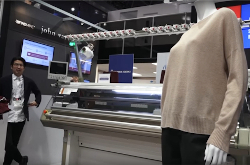쇼핑의 미래

These days, shopping often involves an Internet connection and a laptop or smartphone. However, businesses are now trying to use new technology, such as 3D printing and augmented reality, to bring customers back into stores.
At the National Retail Federation show in New York City, many companies demonstrated these new technologies. One, the computer company Intel, is experimenting with 3D printing. It is using the Mach 2XS commercial printer.
Instead of printing words on paper, the Mach 2XS prints clothes. For example, it uses thread to print out a sweater. It prints the sweater out row by row, until it is fully formed.
Ryan Parker is the general manager of Responsive Retail at Intel. He says the 3D printers print out clothing, made just for the individual in size and style, in about 45 minutes.
More and more consumers shop online. But young people still seem to like going to physical stores. A recent study shows that 67 percent of people between ages 13 to 21 shop in physical stores most of the time. The IBM Institute for Business Value and the National Retail Federation did the study.
A London-based company, Ads Reality, is trying to use augmented-reality, or AR technology in stores. Augmented reality is a technology that creates computer-generated images and projects them in a way that they look real.
“When it’s used in the right way, it’s a very powerful tool to drive mobile engagement and store traffic,” said Richard Corps, managing director.
The company’s latest product is an “AR Window.” It superimposes life-sized augmented-reality characters on big screens in store windows.
“It looks like these characters are actually inside the store ... it stops people outside the store because they’re amazed to see these characters ... and then it drives them inside the store because they want to have their photograph taken with these characters,” Corps said.
Customer service robots might also become a common store experience. The New York company Autonomous is experimenting with customer service robots. These wheeled devices include a Wi-Fi connection to a real person who can be seen on the robot’s screen.
Robots in a hardware store, for example, could be operated from anywhere by experts in different fields, like plumbing or electrical wiring.
Autonomous chief Duy Huynh says the robots can make the shopping experience personal.
“With our technology, when you walk into a store one of our robots will approach you and behind the robot, [it’s] going to bring someone who knows your shopping habits, who has been helping you for the past six months, who knows what you need, to talk to you.
So to us that’s really, really important and that’s the very first time you can actually do personalization offline.”

